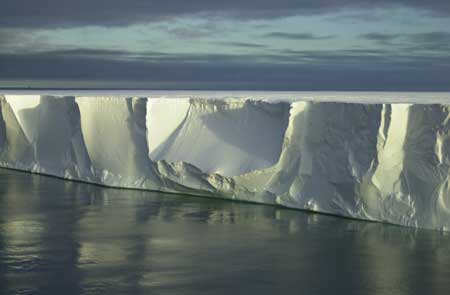by Larry
December, 2006Ice Perils But Fresh Water from Record-Breaking BergsYet, B9 was not actually the biggest of the bergs. That designation would have gone to B15. It broke off from the Ross Ice Shelf on 3/12/00 with a length of 183 miles, a width of 22 miles, and an overall area (over 4000 square miles) about as large as Connecticut or Jamaica. Over the past 2-3 decades, a number of behemoth icebergs (at least 17) have broken free of Antarctic ice shelves. They are appearing at a rate of one about every couple years. B10A, about 1000 square miles, has been blocking sea lanes near the tip of South America. Another such monster ran aground on Australia's southern coast decades ago and remains a mountain of ice there.
The mammoth icebergs have blocked access to open ocean food for millions of penguins, which have then perished. Although the biggest berg, B15, broke apart in 2001, one of its smaller descendents, still about the size of Rhode Island, for several months prevented the resupply of U.S.'s McMurdo Station, New Zealand's Scott Base, and Italy's Terra Nova base in late 2004 to early 2005. Besides impeding shipping in their own right, likes bulls causing great breakage in the proverbial China shop, the monsters often leave thousands of smaller icebergs in their wake as they gradually melt, are damaged by storms, or run aground against coastlines, ice shelves, or glaciers. These little bergs, house size or smaller, are often hard to track via satellite imagery or radar and can be a threat to shipping in themselves. On the plus side, as the world is becoming more concerned over a scarcity of fresh water, enormous icebergs may be one answer. It has been estimated, for instance, that B15A, the "main body" after B15 broke in 2001, by itself could provide as much fresh water as the River Nile's flow for the next 80 years. Companies that can transport portions or all of giant icebergs to parched areas have the potential to make good profits. The purchases and sales of such "super-bergs" may in future be part of a new commodities market. A single giant berg might go for hundreds of billions of dollars. To date, however, attempts to forecast the huge icebergs' movements have met with failure. We shall need to know a lot more about how these ice titans are likely to react to a variety of natural or manmade forces before their commerce can become the norm. Also needing resolution are significant environmental and transportation (maritime and military) concerns with the movement of vast volumes of fresh water ice through thousands of miles of ocean. Scientists think the increasing calving off the Antarctic ice shelves of gargantuan icebergs may be related to global warming. In any case, whether it will prove more boon or bane, the "super-berg" phenomenon is likely to be around at least for the balance of the 21st Century.
Bergs with Minds of Their Own: Daring Science Mission Targets Giant Slabs of Ice. Josh Landis in The Antarctic Sun, 10/22/00. Icebergs Ahoy. Holly Hartman in Fact Monster, 2006. Massive Iceberg Wreaks Havoc on Antarctic Marine Ecosystem. Mark Shwartz in Stanford Report, 10/2/03. World's Biggest Iceberg Begins Moving after Blocking Food Supplies for Antarctic Stations, Penguins. Associated Press in Environmental News Network, 4/4/05. |
